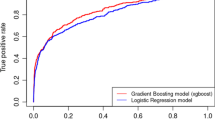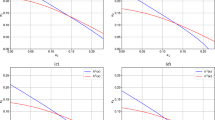Abstract
Recent empirical evidences indicate that default rates are influenced not only by the observable or latent risk factors, but also depend on the history of past defaults. Motivated by this empirical finding, we consider in this paper a reduced-form, intensity-based credit risk model, which allows for both frailty and default contagion, using a so-called “self-exciting” intensity, in the sense that the default intensity varies not only with the risk factors, but also depends on the previous default history of all the firms. With “self-exciting” default intensity, we are able to obtain closed-form expressions for the pricing of credit derivative securities in our model. The estimation of parameters using the EM algorithm is considered as well.
Similar content being viewed by others
Notes
In Azizpour et al. (2014), an observable factor is also included in the model to represent the macro-economic risk factor. Our model and filtering-based approach can be easily extended to allow for observable risk factors, as observable factors will not change the filtering equations essentially. For simplicity, we only model the latent frailty and contagion effects through the hidden, unobservable Markov state process, as our main focus is to filter out the current state with the “self-exciting” default intensity, which is a novel contribution. We also obtain the robust filter with the “self-exciting” default intensity.
In Azizpour et al. (2014), the frailty factor is modeled as a mean-reverting CIR square-root diffusion process.
In Giesecke and Schwenkler (2014), the authors consider a filtered likelihood estimate of parameters for marked point processes. Using numerical analysis, they compare estimates obtained with their approach and with the EM algorithm, and find that for the majority of the parameters, their estimates are more accurate and less susceptible to the initial values.
For \(\lambda ^i_t\) of the special form \(\lambda ^i(t,X_{t-},N_{(\cdot )})=\phi \left( \int _{-\infty }^th(t-s,X_{t-})dN_s\right) \), appropriate conditions for integrability are given by researchers. A key example of interest is when \(\lambda ^i(t,X_{t-},N_{(\cdot )})=\langle \alpha ,X_{t-}\rangle +\langle \beta ,X_{t-}\rangle \int _0^t e^{-\langle \gamma ,X_{t-}\rangle (t-s)}dY^i_s\), where \(Y^i_t=\sum _{j\ne i}N^i_t=\sum _{j\ne i}{\mathbf {1}}_{\{t\ge \tau _i\}}\), and \(\alpha ,\beta ,\gamma \) are vectors of parameters to be determined. This is a variant of the Hawkes’ process.
For example, a variant of the Hawkes’ process is \(\lambda ^i(t,X_{t-},N_{(\cdot )})=\langle \alpha ,X_{t-}\rangle +\langle \beta ,X_{t-}\rangle \int _0^t e^{-\langle \gamma ,X_{t-}\rangle (t-s)}dY^i_s\), where \(Y^i_t=\sum _{j\ne i}N^i_t=\sum _{j\ne i}{\mathbf {1}}_{\{t\ge \tau _i\}}\), and \(\alpha ,\beta ,\gamma \) are vectors of parameters to be determined. This is a parametric specification where \(\lambda ^i(t,X_{t-},N_{(\cdot )})\) is self-exciting, and not depending on \(N^i_{[0,t-]}\).
References
Azizpour, S., Giesecke, K., Schwenkler, G.: Exploring the Sources of Default Clustering. Working paper, Stanford University (2014)
Bielecki, T.R., Rutkowski, M.: Credit Risk: Modeling, Valuation and Hedging. Springer, Berlin (2002)
Black, F., Cox, J.C.: Valuing corporate securities: some effects of bond indenture provisions. J. Finance 31(2), 351–367 (1976)
Collin-Dufresne, P., Goldstein, R., Helwege, J.: Is Credit Event Risk Priced? Modeling Contagion Via the Updating of Beliefs. Preprint, Carnegie Mellon University (2003)
Cvitanić, J., Ma, J., Zhang, J.: Laws of large numbers for self-inciting correlated defaults. Stoch Process Appl 122, 2781–2810 (2011)
Das, S.R., Duffie, D., Kapadia, N., Saita, L.: Common failings: how corporate defaults are correlated. J. Finance 62(1), 93–117 (2007)
Duffie, D., Lando, D.: Term structure of credit spreads with incomplete accounting information. Econometrica 69, 633–664 (2001)
Duffie, D., Singleton, K.: An econometric model of the term structure of interest-rate swap yields. J Financ 52(4), 1287–1321 (1997)
Duffie, D., Singleton, K.: Modeling term structures of defaultable bonds. Rev Financ Stud 12, 687–720 (1999)
Duffie, D., Singleton, K.: Credit Risk: Pricing, Measurement and Management. Princeton University Press, Princeton (2003)
Duffie, D., Eckner, A., Horel, G., Saita, L.: Frailty correlated default. J Financ 64, 2089–2123 (2009)
Elliott, R.J., Aggoun, L., Moore, J.B.: Hidden Markov models: Estimation and control. Applications of Mathematics (New York), 29, Springer, New York, xii+361 pp (1995)
Frey, R., Runggaldier, W.: Pricing credit derivatives under incomplete information: a nonlinear filtering approach. Financ Stochast 14, 495–526 (2010)
Frey, R., Schmidt, T.: Pricing and hedging of credit derivatives via the innovations approach to nonlinear filtering. Financ Stochast 16, 105–133 (2012)
Giesecke, K., Longstaff, F., Schaefer, S., Strebulaev, I.: Corporate bond default risk: a 150-year perspective. J Financ Econ 102, 233–250 (2011)
Giesecke, K., Longstaff, F., Schaefer, S., Strebulaev, I.: Macroeconomic effects of corporate default crises: a long-term perspective. J Financ Econ 111, 297–310 (2014)
Giesecke, K., Schwenkler, G.: Filtered likelihood for point processes. Working paper. Stanford University (2014)
Giesecke, K., Spiliopoulos, K., Sowers, R.: Default clustering in large portfolios: typical events. Ann Appl Probab 23(1), 348–385 (2013)
Hajek, B., Wong, E.: Stochastic Processes in Engineering Systems. Springer, Berlin (1985)
Jarrow, R.A., Turnbull, S.M.: Pricing derivatives on financial securities subject to credit risk. J Financ 50, 53–86 (1995)
Jarrow, R.A., Lando, D., Turnbull, S.M.: A Markov model for the term structure of credit risk spreads. Rev Financ Stud 10(2), 481–523 (1997)
Karatzas, I., Shreve, S.E.: Brownian Motion and Stochastic Calculus. Springer, Berlin (1988)
Merton, R.C.: On the pricing of corporate debt the risk structure of interest rates. J. Finance 29(2), 449–470 (1974)
Schönbucher, P.: The term structure of defaultable bond prices. Rev Deriv Res 2, 161–192 (1998)
Schönbucher, P.: Information Driven Default Contagion. Working Paper, ETH, Zurich (2003a)
Schönbucher, P.: Credit Derivatives Pricing Models: Models, Pricing and Implementation. Wiley, Chichester (2003b)
Acknowledgments
The authors thank the anonymous referee for many comments and suggestions, which are very helpful.
Author information
Authors and Affiliations
Corresponding author
Additional information
The first author wishes to thank SSHRC and NSERC.
Appendices
Appendix 1
Proof of Theorem 1
We have
Then
As \(\varLambda \) has independent increments under  , taking a conditional expectation,
, taking a conditional expectation,

As \(\lambda ^i\) is a scalar function of the state \(X_{u-}\), we can write
where \({{\mathrm{diag}}}(\lambda ^{(i)}-1)\) is the diagonal matrix with \((k,k)\)-entry \(\lambda ^i_{k,u}=\lambda ^i(u,e_k,N_{(\cdot )})\). This implies that \({{\mathrm{diag}}}(\lambda ^{(i)}-1)\) is \({\mathcal {F}}^Z_u\)-measurable. Substituting this in the equation for \(q\), we have
\(\square \)
Proof of Theorem 2
The proof is similar to that of Theorem 1. We start with \(\overline{{\mathbb {P}}}\). Using Girsanov’s Theorem for jump processes, define a process \(\varLambda _t\) by
Using Itô’s rule, we also have
or
Since
we have
Write \(q_t:=\overline{{\mathbb {E}}}[\varLambda _tX_t|{\mathcal {F}}_t^M]\). Then, a version of Bayes’ Theorem gives
Conditioning on \({\mathcal {F}}_t^Z\) under \(\overline{{\mathbb {P}}}\), using the Fubini Theorem in Hajek and Wong (1985), we have
Write \(H^i_k(u):=h^i_k(y_u)\). Then
\(\square \)
Proof of Lemma 2
By Itô’s product rule,
Thus
\(\square \)
Proof of Theorem 3
By Itô’s product rule,
Thus
\(\square \)
Appendix 2
In this appendix, we give a closed-form expression for the survival probability in our model with self-exciting intensities. We show that, if we exclude some uninteresting technical cases, a closed-form expression for the survival probability can be obtained. In our model, \(\lambda ^i(t,X_{t-},N_{(\cdot )})\) depends on \(X_{t-}\), and \(N^j_{[0,t-]}\), for all \(j\ne i\). We further assume the following, to exclude some uninteresting cases.
Assumption
\(\lambda ^i(t,X_{t-},N_{(\cdot )})\) does not depend on \(N^i_{[0,t-]}\).Footnote 5
We make this assumption as we use \(\lambda ^i(t,X_{t-},N_{(\cdot )})\) to model the contagion and frailty effects from other firms, so \(\lambda ^i(t,X_{t-},N_{(\cdot )})\) does not depend on its own default history. Also, when \(N^i_{t-}=0\), \(N^i_{[0,t-]}\) does not influence \(\lambda ^i(t,X_{t-},N_{(\cdot )})\), and once \(N^i_{\tau _i}=1\) for \(\tau _i<t\), firm \(i\) has already defaulted. Thus, it is sensible to assume that \(\lambda ^i(t,X_{t-},N_{(\cdot )})\) does not depend on \(N^i_{[0,t-]}\).
With this assumption, we now prove the survival probability. By definition of stochastic intensity (see, e.g., Duffie and Singleton 2003 p. 361; Bielecki and Rutkowski 2002 p. 155), the compensator of \(N^i_t\) is \(\int _0^{t\wedge \tau }\lambda ^i(u,X_{u-},N_{(\cdot )})du\), i.e.,
is an \({\mathcal {F}}\)-martingale under measure \({\mathbb {P}}\). We need to find the survival probability \({\mathbb {P}}(\tau _i\ge t|{\mathcal {F}}_t)\).
The filtration \(\{{\mathcal {F}}^{X}_{t},t\ge 0\}\) is defined by \({\mathcal {F}}^{X}_{t}:{=}\sigma \{X_{s}:s\le t\}\). Similarly, we write \({\mathcal {F}}^{Z}_{t}=\sigma (Z_{s};0\le s\le t)\). Note that in our setting, \({\mathcal {F}}_{t}=\sigma (X_{s},Z_{s};0\le s\le t)\).
We have
Now we calculate the first conditional expectation in equation (4). Since \(\lambda ^i(u,X_{u-},N_{(\cdot )})\) does not depend on \(N^i\) (or \(\tau _i\)) conditional on \(\tau _i\ge t\), we have
Now we calculate the conditional expectation in the second term in Eq. (4). For \(\tau _i\le t\), \(\int _0^{\tau _i}\lambda ^i(u,X_{u-},N_{(\cdot )})du\) depends on \(X_{u-}\), \(N^j_{[0,u]}\), \(j\ne i\), and \(\tau _i\). Then
Thus from Eq. (4) we have
Denoting \(p(t)={\mathbb {P}}(t|{\mathcal {F}}_s)={\mathbb {P}}(s<t|{\mathcal {F}}_s)\), we have from Eq. (5)
Differentiating the above equation, we have
The above differential equation is equivalent to
which yields
Thus
This proves the desired probability. \(\square \)
Rights and permissions
About this article
Cite this article
Elliott, R.J., Shen, J. Credit risk and contagion via self-exciting default intensity. Ann Finance 11, 319–344 (2015). https://doi.org/10.1007/s10436-015-0259-z
Received:
Accepted:
Published:
Issue Date:
DOI: https://doi.org/10.1007/s10436-015-0259-z




